New Dubai
The Tourism Ministry has suddenly become very ‘open’. Earlier it was impossible to find any statistics, whereas now it is releasing reports at one after the other. Why has it become so “kind”? It’s that the procedure to obtain a visa has been simplified for citizens of the United Arab Emirates (UAE) since November 2015, and for citizens of Qatar, Oman, Saudi Arabia, Japan, China, Singapore and other countries, the same has been the case since February 1, 2016. This measure has has been effective only with regard to the United Arab Emirates and Bahrain. For example, the number of tourists from Bahrain has increased from 42 to 322. Naturally, there hasn’t been any rapid development of the industry, but that doesn’t prevent the Tourism Ministry from boasting the fact that the number of tourists travelling from the UAE to Azerbaijan has increased by 100 times in July of this year, as compared to July of last year.
The more the Azerbaijani economy gets stuck in a crisis, the more talks there are about the development of tourism. For some unclear reason, the government believes that the development of tourism is the ‘easiest’ solution that isn’t based in the oil sector. However, regrettably, it’s been all talk and no action. Although two tourism development programs have been adopted in Azerbaijan since 2002, the country still cannot compete with neighboring Georgia in this area. Nevertheless, the country’s government is trying to demonstrate a ‘growth’ in the tourism sector, often referring to the tourism’s 4.5% share in the GDP, etc.
Crowds of tourists will come
For a start, let’s define who a tourist is. According to the UN World Tourism Organization (UNWTO), a tourist is ‘an individual, who, based on personal motives, is travelling for business, tourism or other purposes for a period of 24 hours to 12 months, who is not remunerated for what he does.’ Curiously enough, in Azerbaijan, nearly all people visiting the country fall into the tourist category. There is even a graph with statistics about ‘individuals staying in the country for less than 1 day.’ Only people who have come to the country for work (84,000 in 2015), don’t fall into this tourist category. Interestingly, up until 2011, individuals visiting relatives or friends, weren’t classified as tourists. Then, the State Statistics Committee decided to refer to them as tourists. As a result, in 2011, the number of tourists suddenly increased by 274,000 (due to 374,000 people visiting their relatives), while in 2012, the amount of tourists increased by 424,000 (the number of people visiting their relatives was 608,000).
Speaking about the overall number of tourists in Azerbaijan, in their official statements the ministries and various agencies indicate the total number of people visiting the country. That is why it is often said that in 2011 (which was declared the ‘Year of Tourism’), the country overcame a 2 million threshold (though officially there were just 1.5 million tourists), while in 2013, it surpassed the 2.5 million threshold. Therefore, the figures voiced by the agencies should be taken with a grain of salt. Nevertheless, even if all the foreigners visiting Azerbaijan are regarded as tourists, they are less than the amount of Azerbaijanis travelling abroad for touristic purposes.
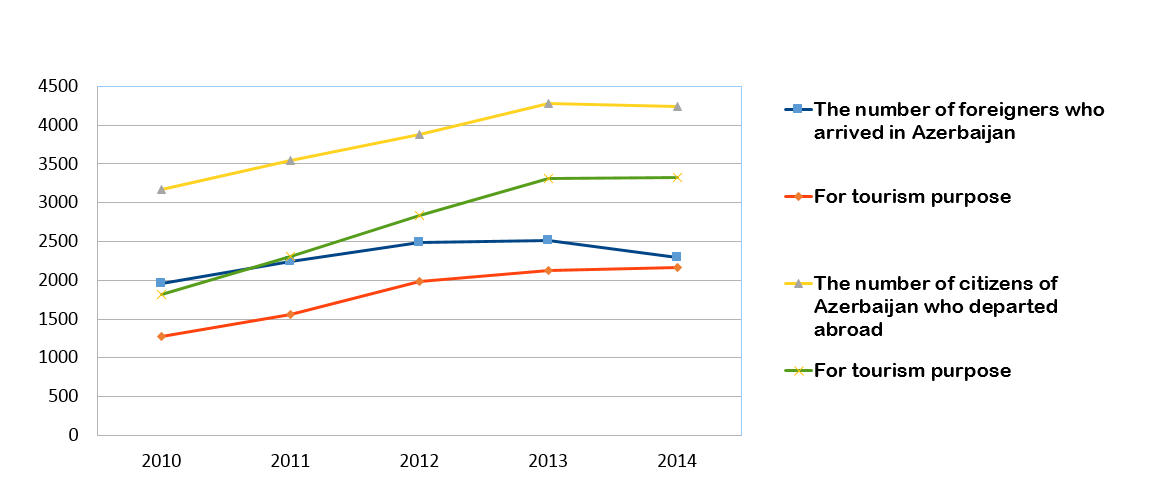 The number of tourists who entered and departed Azerbaijan (in thousands of people)
The number of tourists who entered and departed Azerbaijan (in thousands of people)
They will spend a lot of money here
It’s unclear where the government’s efforts to promote tourism in the country go. After all, the main goal of the development of tourism is to attract foreign exchange to the country. Tourism itself cannot generate huge profits (for example, according to 2015 official data, companies engaged in tourism earned 5.5 million AZN). However, it’s a permanent and stable source of foreign exchange, needed for countries like Azerbaijan, which have few sources of the foreign exchange, especially in light of the devaluation of their currency and the crisis.
However, income from foreign exchange in tourism don’t influence anything, since Azerbaijanis spend more on ‘tourism services’ abroad than foreigners in Azerbaijan.
 Tourism service costs (in mln. dollars)
Tourism service costs (in mln. dollars)
Tourism revenues in our country have had a negative on the country and reached a low in 2012.Many international projects were carried out in Azerbaijan that year, attracting thousands of visitors. There were various festivals and conferences, as well as many other events. Their number considerably dropped in subsequent years, reaching a low in 2015 and there were fewer attempts to fully recover foreigners’ costs than there had been previously.
Tourism is actually profitable only for the local and foreign airlines, while the rest of the economy can’t even ‘feel’ the tourists who visit.
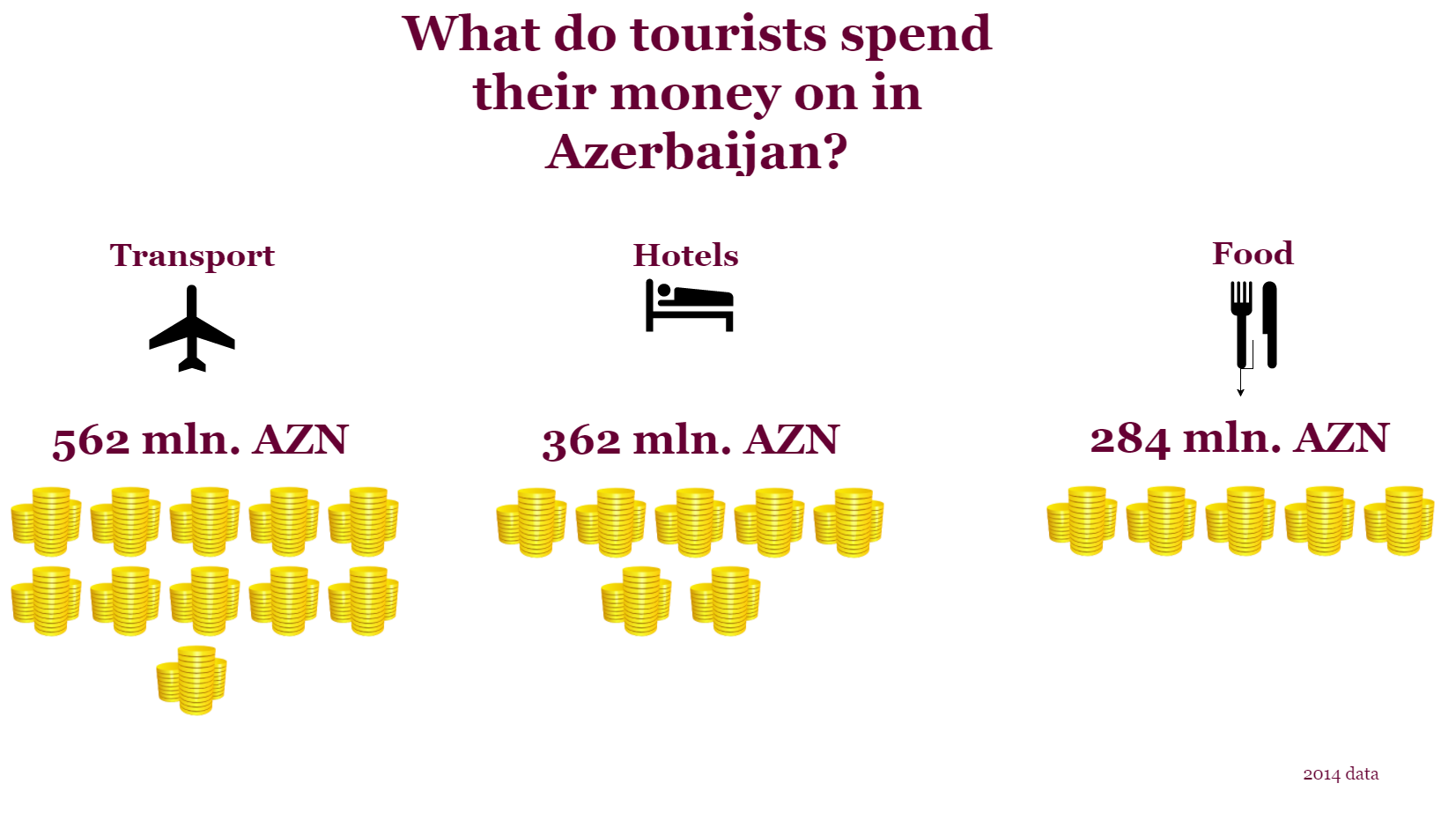
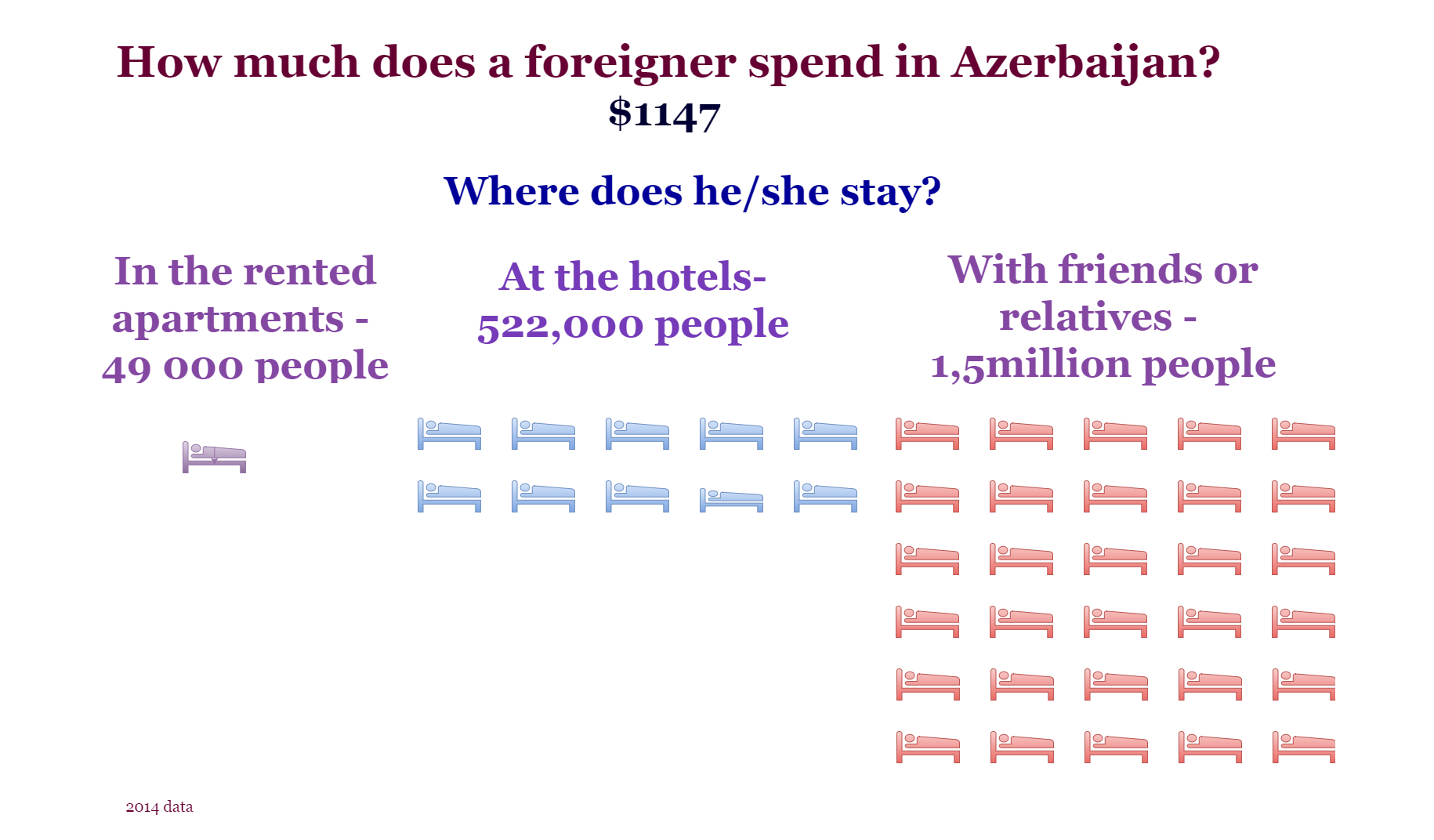
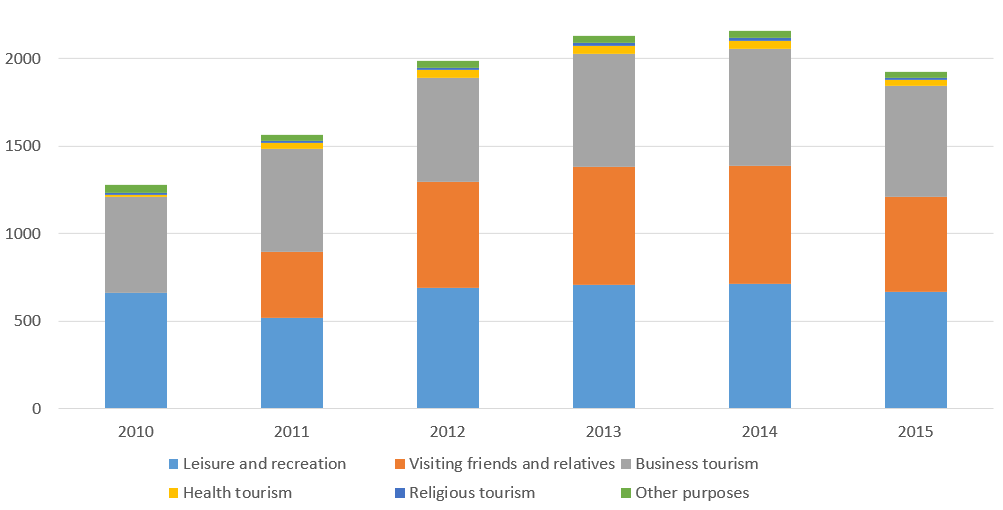 The purpose of tourists traveling to Azerbaijan (thousands of people)
The purpose of tourists traveling to Azerbaijan (thousands of people)
The majority come here not to spend the money, but rather to visit their relatives and conclude contacts (participate in conferences etc.).
Tourists come here from all over the world
In addition, most of the tourists arriving in Azerbaijan travel from certain countries. According to Nazim Samedov, the Deputy Minister of Culture and Tourism, up to 95% of tourists come from Russia, Georgia, Turkey and Iran. In all fairness, according to the official statistics, this number is lower, but they still make the vast majority. There have been certain changes just recently. The share of these top four countries has somewhat declined (especially after the ‘Arab Summer’), but they still hold the dominant position, in general.
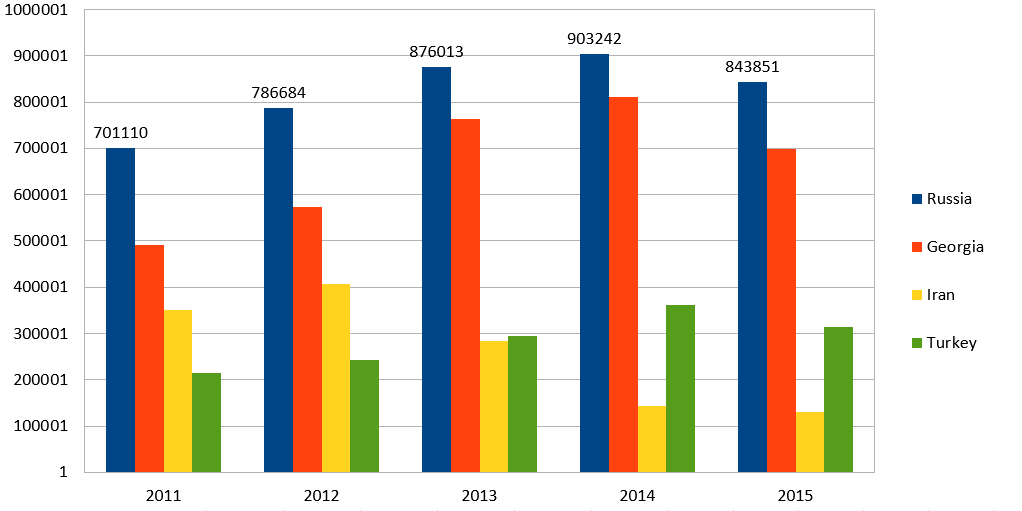 Top four countries by the number of foreigners visiting Azerbaijan
Top four countries by the number of foreigners visiting Azerbaijan
Thus, as far as we could see, the situation with tourism in Azerbaijan is not good, to say the least of it. The main tourist flow is either the Azerbaijanis, who earlier left for Russia, Turkey, Israel and who are now visiting their relatives and friends, or the Georgian and Iranian Azerbaijanis. At the same time, there were no particular changes in 2015 either. Their overall share just slightly dropped and made 84,5%. In fact, there is no need to hold special events, since these people will travel here for no particular reason.
There are practically no ‘international tourists’ in the traditional sense here. Their share made just 7-8% in 2014.
New Dubai
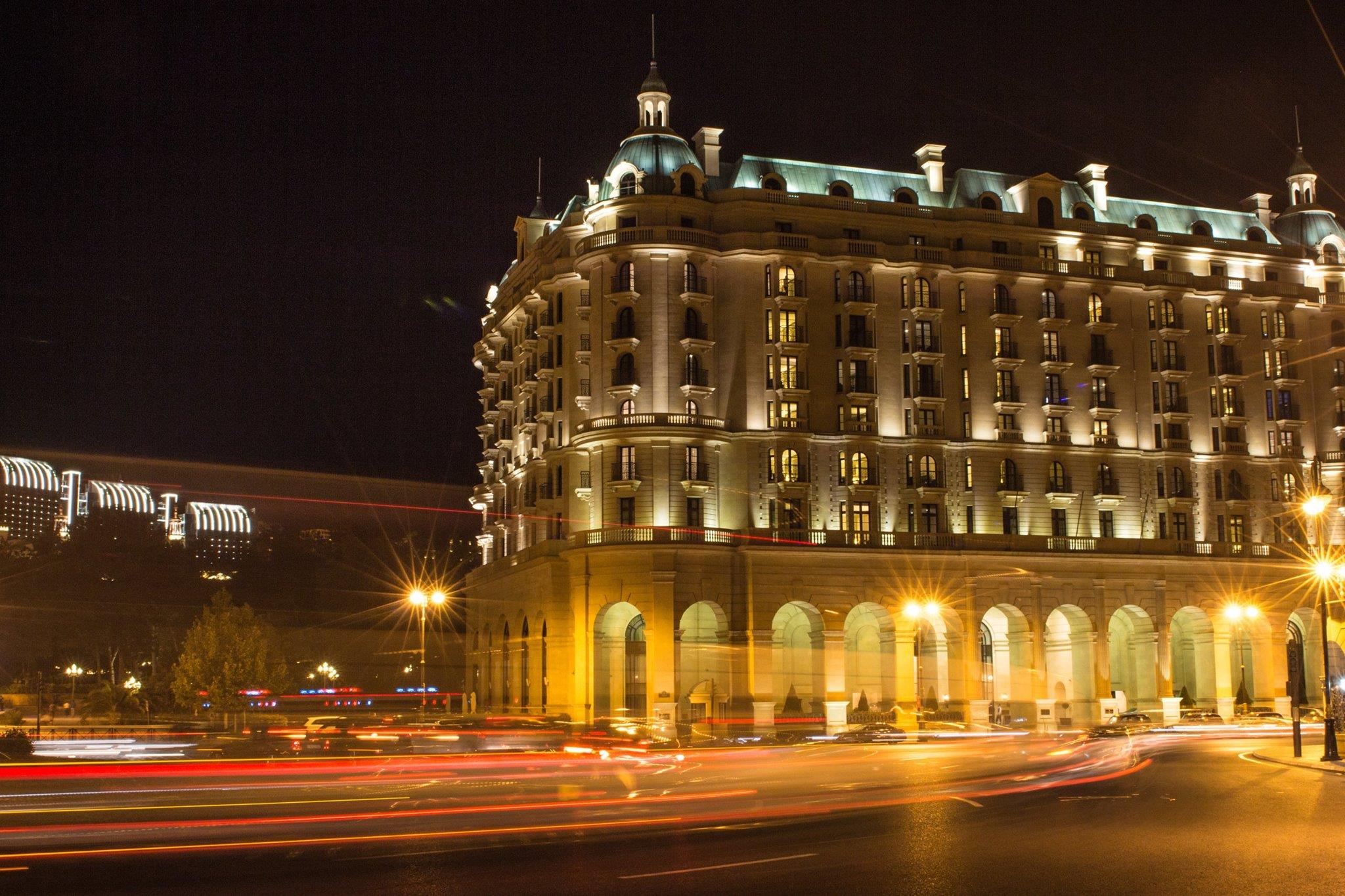 Four Seasons, Baku
Four Seasons, BakuSpeaking about the tourism development problems in the country, many experts believe, there are essentially two factors necessary for the development of this sphere: an objective need and availability of relevant infrastructure.
There isn’t anything that particularly distinguishes Azerbaijan from other resorts, in general. There are just few unique places. For example, the Naftalan health resort, where the unique Naftalan oil is extracted. In the 80s, Naftalan hosted a record number of tourists-75,000 thousand people per year with the city population amounting to 3,000 (just few of them employed in the tourism sector). Officially, the population of the city makes 10,000 people, and the record number of tourists was reported in 2015-16,000 tourists, including international tourists – only 3,000. We don’t even use the existing potential (as the city’s local authorities claim, the city is allegedly capable of hosting 2,000 tourists per day, though it received just 3,000 people throughout Q1 2016).
There are some other ‘tricks’ that could be used, but we are currently following a kind of ‘Dubai path’, not thinking much of who is going to visit Baku if there are Dubai and Istanbul.
The infrastructure is also lagging behind. Officially, there are just 19,000 suites and about 38,000 beds. For example, Marmaris (Turkey) can receive 40,000 people per day (3,3million people visit Marmaris annually, whereas 2million people visited Azerbaijan in 2015). As far the prospects are concerned, there also problems here. According to the “JLL International Consulting Company’s data, 1,200 hotel suites were put into operation in the country in 2015. Thus, we were ranked the 2nd after Russia. We were the 3rd the year before. However, in 2016, it is officially planned to put only 148 suites into operation. Thus, we will be the second to last, yielding to nearly all CIS countries.
149 out of 340 hotels, registered with the Azerbaijani Tourism Ministry, are located in Baku. At the same time, among 100 star-rated hotels there are 25 ‘5-star’ and 20 ‘3star’-hotels. In other words, every 4th hotel in the country is a ‘5-star’ hotel, while the average world index is every 10th. And the hotels, opened in the recent years, are mostly the 5-star ones.
It turns out that we are actually developing only the tourism trend that is aimed at the rich, the ‘aristocrats.’ But here comes the question –what for? Their overall number doesn’t exceed 1% of the total world population. They already spend their vacation in the USA, Europe, Dubai. No one will surely come here for the sake of the Caspian Sea. In addition, this field of tourism could be profitable for a certain entrepreneur rather that bring revenues to the whole country.
Once, before some major event, the French Ambassador to Azerbaijan noted that a flight from Paris to Baku would cost an average Frenchman the same price as that of a three-week tour to Portugal, with the accommodations in a 3-star hotel. In view of such costs, it becomes quite clear why a French citizen will travel to Portugal, Spain, Tunisia, or somewhere else, rather than to Azerbaijan. The expensive air tickets, visa delays, costly hotels also do their bit.
Of course, there have been some changes. For instance, the visa costs have been reduced, the accommodation expenses have dropped due to devaluation of the national currency. However, that’s not the reason for substituting Azerbaijan for Georgia or Tunisia.
Eurovision helped us
 Crystal Hall, Baku
Crystal Hall, BakuIn any case, the government claims that the Eurovision Song Contest, the 1st European Games and Formula-1 improve Azerbaijan’s image and attract tourists to the country. But let’s take a closer look at them and how many tourists they attracted. For this purpose, we should use the official data that were made public immediately after the events.
As the Ministry of Culture and Tourism reported, 103,000 people arrived in Azerbaijan within 15 days during the Eurovision-2012. At the same time, the participants’ delegations made 6-7,000 people. 50,000 people arrived for the tourism purposes. But the Eurovision lasted just for 6 days, rather than 15 days. According to the Azerbaijani Tourist Association, over 10,000 people visited Azerbaijan in during the song contest (consequently, 95% of Baku’s hotel suite stock were occupied). If taking into account the participants’ delegations of 6,000-7,000 people, the number of tourists made 3,000-4,000. According to some other data, 7,000 tourists arrived in Azerbaijan in that period (for comparison, 39,000 tourists arrived in Denmark during the Eurovision 2014), who spent the average of US$10million in the country.
According to the MFA, over 28,000 foreigners arrived in Baku for the European Games. This number includes the squads, the technical staff and the reporters (their total number reached 12,000). In other words, nearly half of the foreigners arrived here at our expense.
As far as Formula-1 is concerned, Baku International Airport has shared some interesting data: 71,000 people departed the country and 41,000 passengers (including technical staff-800) arrived within the period from June 10 till June 22. But not all of them are tourists. Let’s not forget about our citizens leaving abroad, and that’s about 24,000 within 13 days. The total of 17,000 (excluding the technical staff-1,000 people).
Thus, the events rating looks as follows:

Overall US$3,8billion, 250million and 721million were spent (including on construction of the Crystal Hall). Thus, the total of US$5121million were spent for the sake of 59,000 foreigners (including the participants–20,000).
You may spout about the tourism revival as much as you want, but statistics is a stubborn things, and it shows that this trend of economy is unlikely to develop in the foreseeable future. The only achievement of the entire Azerbaijani tourism in 2016 was that 44,000 Iranians visited Baku on the Novruz holiday. Their total expenditures couldn’t exceed US$30-35million (apparently they were even less; there are no official data available in this regard). Such an ‘influx’ led to overcrowding of the city hotels and overloading of the relevant infrastructure. So, if the tourists from Europe had suddenly decided to travel here those days, there simply would have been no place for them to live.
Data of the State Committee on Statistics and Information, obtained from the open sources, have been used in the article:
http://www.cbar.az/lpages/statistics/external-sector-statistics/
http://stat.gov.az/news/?id=2887
http://www.kaspiy.az/news.php?id=28787
http://news.day.az/society/774756.html
http://mct.gov.az/styles/doc/mehmanxana.pdf
Published 30.08.2016



















